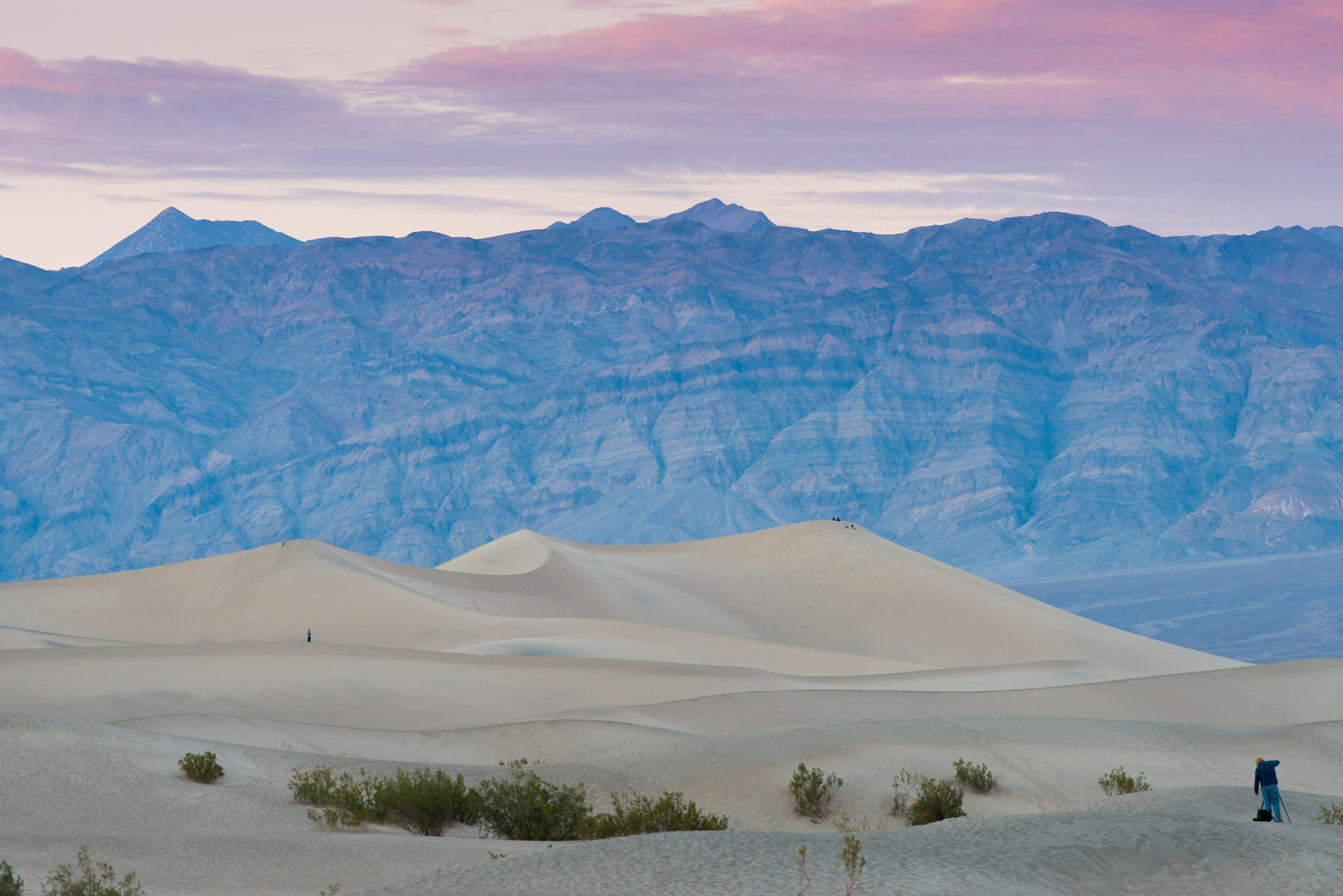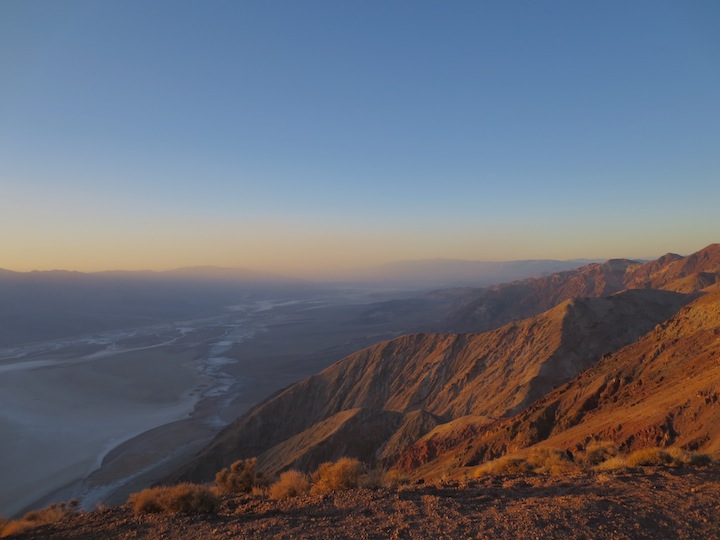The name may seem foreboding—even gruesome—however, in its own way, Death Valley has more “life” than the bustling cities nearby. You just have to look and listen a little harder. Only 120 miles northwest of Las Vegas and a few hours from Greater Palm Springs, another world unfolds as you enter the realm of Death Valley National Park. Surrounded by stark, pristine beauty and the serenity found only in pure nature, the parkland shares only one thing in common with Vegas—the Mojave Desert—and even that is difficult to find wedged between the eternal glitz and revelry of the metropolis. When you detour to Death Valley, you won’t merely “see” the differences—you’ll “hear” them. The quiet that encompasses Death Valley slowly gives way to the sounds of the open desert—from slightly shifting sand dunes to burrowing animals and the swoosh of birds in flight. When you make your ascent to Dante’s View here, the overwhelming uniqueness of the region is revealed as you gaze upon the highest place in the contiguous forty-eight states—Mount Whitney, at 14,496 feet—as well as the lowest—Badwater, at 282 feet below sea level.
On the Way to Death Valley
Getting to Death Valley can be the best part of the journey. There are several ways of reaching Death Valley, but one back route with interesting scenery is through Emigrant’s Pass.
On the way from Barstow to the pass, take Highway 395 to State Highway 178 to view the Trona Pinnacles. The 500 tufa pillars shoot up from the desert floor to heights of more than 130 feet. These calcium-carbonate formations, not as well-known as those at Mono Lake, are located straight ahead when you see the Leslie (Salt) Road. Created by dried lakes, the tall salt rocks form shapes that will give your imagination a workout. You’ll see castles for sure and perhaps a royal drawbridge, as well.
After viewing the Pinnacles, head into the town of Trona for a refueling stop, and then continue on, taking the Trona Wild Rosa Highway to Emigrant Canyon in Death Valley. Watch for the wild burros that roam the scrubby flats. The 550-mile loop through Death Valley and adjacent areas is an ambitious journey, so pick out some side trips and enjoy.
Stop by Furnace Creek Visitor Center
Once within the confines of Death Valley, begin your explorations with a stop at the Furnace Creek Visitor Center located on California Highway 190. An informative 20-minute park film is shown throughout the day. During the winter season, November to April, rangers present a wide variety of walks, talks, and slide presentations about Death Valley's cultural and natural history.
Wander Dunes
Discover Death Valley’s magic first hand on an early morning walk near Stovepipe Wells with an up-close view of the 14-mile-square expanse of sand dunes. The footprints of the desert’s many nocturnal animals can be spotted as the sunrise casts dramatic shadows on the contours and ripples of the eroded quartz dunes. Sunset and moonlight also cast their own special effects on the flowing slopes.
Mesquite Flat Sand Dunes are the best known and easiest to visit in the national park. Located in central Death Valley near Stovepipe Wells, access is from Hwy. 190 or from the unpaved Sand Dunes Road. Although the highest dune rises only about 100 feet, the dunes actually cover a vast area making them the largest dune field in the park. Mesquite offers three types of dunes: crescent, linear, and star-shaped. Polygon-cracked clay of an ancient lakebed forms the floor. Mesquite trees have created large hummocks that provide stable habitats for wildlife.
The Eureka Dunes are the second tallest dunes in the country, towering more than 700 feet. Created by sand carried by winds from the northern end of the valley, the dunes’ early-morning and late-afternoon shadows make an unforgettable mark on the soft flowing edges. The dunes are located about 10 miles off Eureka Valley Road and provide easy wandering or strenuous climbing if you are going to the top, but the views of the reddened Last Chance Mountains make the sandy trudging worthwhile.
Panamint Dunes greet travelers crossing Panamint Valley on Hwy.190, appearing as a distant, pale vision to the north. To get a closer look, drive 5 miles down the unmarked dirt road leading past Lake Hill, then hike cross-country 3 miles. The other dunes of Death Valley are all situated on flat valley floors, but these are perched on a slope. The view from the summit of these dunes reveals their star shape and an impressive view down the valley.
Mine for History
To best appreciate, Death Valley is to understand its history—as fascinating as the scenery. The history of the valley dates back to the Indian cultures that existed here some 9,000 years ago. The first emigrants in the valley came in search of a shortcut on their way to the Mother Lode country in 1849. The hardships they endured before leaving earned the valley its grisly name. By chance, one of these first “tourists” discovered silver, and soon the valley became a boom area for gold, silver, copper, and lead. But it was borax that proved to be the most profitable find in the area.
In 1905, gold was discovered in Death Valley. A man named Bob Montgomery purchased the discovery from miners and began the town of Skidoo. Skidoo was a full company town, with Montgomery at the helm. The town acquired its name after a popular saying at the time, “twenty-three skidoo,” a reference to the mileage (23) that water needed to be piped in from a spring in the Panamint Mountains. At its peak, the town’s population was about 700, and profits filtered in until about 1917. It stands as one of the rare Death Valley mining operations that made a profit, more than $3 million. A few people stayed to get the last of the ore, but by 1950 Skidoo was officially a ghost town.
Experience one of the most unique historical mining sites in Death Valley. In November 2017, the Keane Wonder Mine re-opened after its closure in 2008. Operating in the early 1900s, the Keane Wonder Mine was one of the most successful gold mines in Death Valley. It now remains as one of the best examples of a historical gold mining operation in the national park where miners traveled tramcars one thousand feet down in one mile, with tramway cars carrying the valuable gold-containing ore from the mine to the mill. By 1912, the mine was mostly tapped out and major operations ended. In that time, almost one million dollars in gold was hauled down those cables. Visit the site today and take a look at how this engineering feat was able to move over 70 tons of ore per day down the steep Funeral Mountains.
Rhyolite is a ghost town you can tour today with several remnants that recall the town’s past, including some the walls of the bank, part of the old jail, the privately-owned train depot and the Bottle House—restored by Paramount Pictures in 1925. Rhyolite is just 35 miles from the Furnace Creek Visitor Center.
Scotty’s Castle
In October 2015, a unique California desert icon closed after a massive flash flood changed the surrounding landscape, destroying roads and utilities. Scotty’s Castle had reigned as a “must-see” in Death Valley, not just for the amazing Spanish Colonial architecture, but more for the rich and colorful historical stories and lore. Closed to the public since the devastating flood, the Death Valley Natural History Association has made it possible to tour once again. But this isn’t the same tour that hundreds of thousands took in years past. This one gets a handful of guests up close to what the power of water can do to shape the desert scape in just a few hours. Although Scotty’s Castle is still not projected to open until 2020, join in a Flood Recovery walking tour as offered. The tour allows visitors to get a first-hand look at the ongoing recovery efforts. Check for tour availability and make reservations.
Twenty-Mule Team Days
You’ll also want to linger at the Harmony Borax Works Ruins, shortly before Furnace Creek. Follow a short footpath past the ruins of the refinery that was used to process borax from 1882 to 1889, as well as original twenty-mule-team wagons on display. The Borax Museum itself is located in Furnace Creek and displays the mining machinery and historical exhibits from the borax-mining days, emphasizing the underground mining period. The twenty-mule team tandem transportation that carried the borax across the desert is well-known, but the many uses of borax, in the glass industry, soap, fertilizers, ceramics, cosmetics, and even nuclear reactors, is amazing. The exhibit and living monument remains to show the history of an industry that has grown from a 2,000-ton output in 1882 to well over a 1.5-million-ton production today.
Take an Inspiring Hike or Drive
There are so many hiking and driving opportunities in Death Valley that you can be sure there is something for everyone, depending on what you would like to see. A few stand out as scenic wonders, such as rainbow-hued Desolation Canyon. Besides hiking through what the park calls a “geologic rainbow,” you are apt to spot views of Tatooine from Star Wars. Star Wars, a New Hope, was filmed in the national park a few decades ago when that type of filming was permitted.
For a drive with the same rainbow wow-factor, follow the single-lane road through the eroded hills along Artists Drive. Aptly named, the nine-mile trip passes through colorful desert hills offering geology and vistas, such as Artists Palette.
A landscape of mainly dark lava flows give way to dramatic Rainbow Canyon in northern Panamint Valley. Just below Father Crowley Vista Point, walk east of the parking lot here for an impressive vista of the valley as well.
The Darwin Falls, an easy drive off State Highway 190 just west of Panamint Springs, offers a parking area at the trailhead. The trail follows a creek lined with lush greenery that leads to the striking, 30-foot-high falls. The two-mile trip is a refreshing departure from the scrub and sand, and the falls offer a rare wetlands experience in the midst of the untamed desert scape.
Check Out Amazing Vistas
To appreciate the vastness of Death Valley’s beauty and its endless horizons, all you need to do is catch one of these mesmerizing vistas. Dantes View promises a breathtaking view of the vast desert valley seen from a rocky desert mountaintop at elevation 5,475 feet. Facing west, you’ll take in the view of the Panamint Mountains towering over the lowest point in North America, Badwater Basin, at 282 feet below sea level. The mountains on the far western horizon are the Sierra Nevadas, home to the highest point in the United State, Mount Whitney. If you can time your vista viewing for sunset, you will be in for a special treat.
Probably the most famous viewpoint in the park is Zabriskie Point that overlooks the golden badlands of the Furnace Creek formation. The highly eroded badlands are best viewed at sunrise or sunset.
For a unique “downward” view, a trip to the Ubehebe Crater in northern Death Valley is a must. The 600-foot multi-hued crater carved in the desert rock can be viewed from the parking lot or the more adventurous can hike around the rim. The drive on the North Highway to the crater is also a visual treat, lined in some of the largest alluvial fans in the world.
Stay in a Legend
Goodbye, Furnace Creek Resort and welcome Oasis at Death Valley. Just a short while ago, another venerable icon of Death Valley had a $50 million rebirth and, with it, a new name. The newly coined Oasis at Death Valley includes a 66-room inn that is now the Inn at Death Valley and the 224-room ranch, now the Ranch at Death Valley. Owned and operated by Xanterra Parks & Resorts, those who crave nostalgia would still have the golf course (214 feet below sea level) carrying the Furnace Creek name.
Also seeped in history and lore, the new name is very fitting. Set in the middle of Death Valley, the resort with date plans, ancient waters that bubble to the surface, birds, and wildlife are anyone’s idyllic concept of a desert oasis. My favorite of the two lodging experiences is (and was) the more intimate Inn at Death Valley built into the mountainside where the precious waters originate. The Renaissance brought an additional 11 two-room casitas surrounding the spring-fed pool with sweeping vistas. Speaking of inspiring views, the dining room of the historic retreat has undergone a complete restoration including a turquoise ceiling that matches the Death Valley sky and banquettes that capture every sunset from high above the desert floor.
Find detailed information about Death Valley National Park here or for looking for things to do, click here.

























